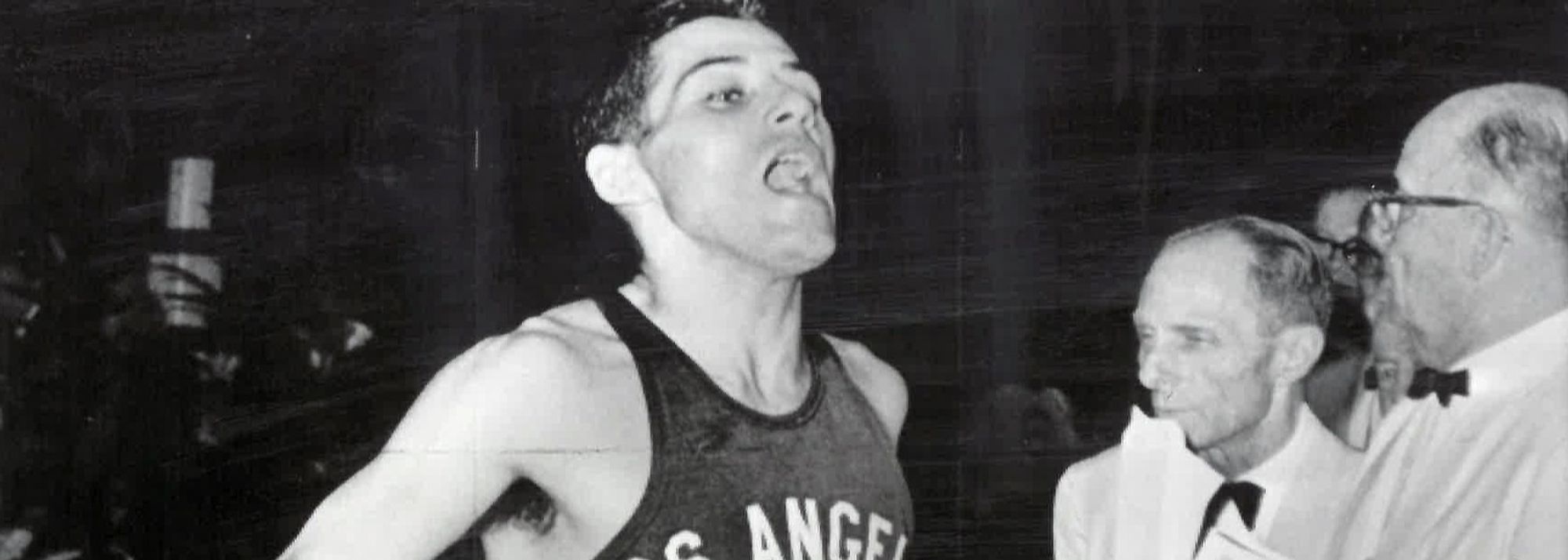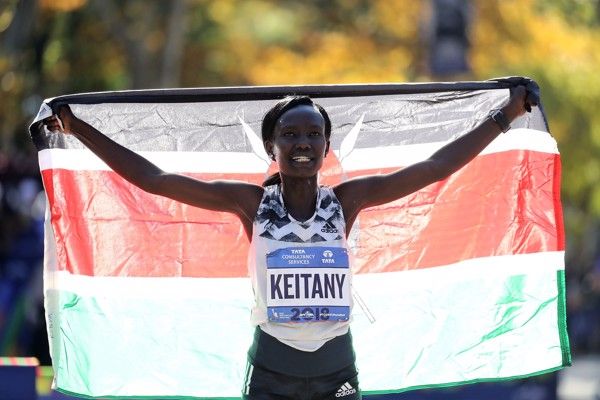Jim Beatty, the world's first indoor sub-four-minute miler, in 1962 (© MOWA)
Whenever Jim Beatty is asked to speak about his enduring niche in track and field history, as the first man to run an indoor mile in less than four minutes, he plays a DVD recording of his landmark race from the Los Angeles Times Invitational meeting on 10 February 1962.
“Although everyone knows the outcome, everyone in the room stands up and cheers as if they were seeing it live,” said Beatty, who has kindly donated one of his spikes (right shoe) from his trailblazing 1962 season to the World Athletics Heritage Collection and the Museum of World Athletics (MOWA). “It is still that exciting.”
It is indeed. Watching the grainy footage, track and field heritage comes to vivid, inspirational life - enhanced by the dulcet tones of Jim McKay, the legendary voice of ABC’s Wide World of Sports, who became renowned for his marathon commentary on the unfolding horror of the Munich Massacre at the 1972 Olympic Games.
“We come to the classic event of any track meet, indoors or out: the one mile run,” McKay trumpeted from his commentary box seat in the Los Angeles Memorial Sports Arena. “This one could really be something, because a four-man team from the Los Angeles Track Club has announced it is going to make a kind of a group assault on the world indoor record.
“It is hoped that one of them, right here and now, can run the mile in less than four minutes. Nobody has ever done it in a place with a roof on it.”
Igloi trained
The four LA musketeers were Beatty, Jim Grelle, Laszlo Tabori and Dave Martin. They were joined by just one other competitor, Lieutenant Pete Close of the US Marine Corps.
It was, of course, a neat, symmetrical reflection of the first successful outdoor assault on the four-minute mile barrier: at Iffley Road in Oxford on 6 May 1954. Roger Bannister’s momentous 3:59.4 had been assisted by the pacemaking of his training partners Chris Brasher and Chris Chataway and orchestrated by their coach, Franz Stampfl.
The LA indoor attempt was plotted by the great Hungarian middle-distance guru Mihaly Igloi, who emigrated to the United States and settled in the Los Angeles area with Tabori, who became the third man to crack four minutes outdoors in 1955 (after Bannister and his great Australian rival John Landy), the year in which he also equalled the 1500m world record.
At the open, exposed Iffley Road track, Brasher toed Bannister to 400m in 58 seconds and 800m in 1:58, then Chataway took him through 1200m in 3:01.
"Little Jimmy" runs sensationally
On the LA boards, with its dizzying 11 laps to a mile, Beatty did more of the running himself.
Tabori led through 400m in 58.9 before Beatty hit the front.
Beatty was a sight to behold as he attacked the clock with all the aggression of the champion boxer he had been in his schooldays in Charlotte, North Carolina.
“One of the gamest runners you’ll ever find in the world,” said McKay of the 5ft 6in “Little Jimmy” (as the North Carolina press dubbed Beatty), with his distinctive barrel-chested build and slightly out-swinging arm carriage.
Grelle, who was to win the Pan Am Games 1500m title ahead of Beatty in 1963, settled in behind as the two men noisily rounded the bend together. “There you hear the feet pounding on boards, the unmistakable sound of indoor track,” McKay noted.
At 800m, with the TV clock reading 1:59.5, Grelle took over in front, pressing on to 1200m in 3:01.2.
At that point, Beatty took off with a vengeance, powering relentlessly clear. “Beatty is running sensationally, and the crowd is going wild,” crowed McKay, before Beatty, head bobbing in the home stretch, crossed the line in 3:58.9.

Mr. Inside
“I still get sweaty palms when I put the DVD on and watch it again,” admitted Beatty in an in-depth interview on garycohenrunning.com. “Nothing has changed. It’s nice when people often refer to me and say things like, ‘Roger Bannister was Mr. Outside and you’re Mr. Inside.’
“I wanted an American to become the first man in the world to go under four minutes indoors,” added Beatty in an interview with Duncan Larkin on the website Bring Back the Mile. “I set out to do it and then I achieved it.
“I had talked to Coach Igloi in late September/early October that I wanted to be the first man to run an indoor mile under four minutes. He designated the LA Times meet as the one where I would go after the record but his modus operandi was to never tell you what the strategy was until five or 15 minutes before a race.
“On that particular evening, Igloi got Jim Grelle, myself and Laszlo Tabori together and laid out the plan and the times for each quarter-mile. He told Tabori that he would go first and run 58 to 59 seconds and I would take over and come in at 1:58/1:59 for the half-mile. Then Grelle would take over and get us to a three-minute quarter mile. After that, it was every man for himself.
“When I felt the pace drop, I took over from the three-quarter mile point. The real motivating factor at that particular point was fear because we were losing time in that third quarter.
“I knew that I would have to make it up somehow and I did shoot out like a rocket. I was going as fast as I could with each step.”
Two-mile world record
Beatty was 27 when he entered the world record books for the first time, taking a mighty 2.5-second chunk off the time set by Ireland’s 1956 Olympic 1500m champion Ron Delany three years previously.
His second global mark came outdoors at Occidental College in Los Angeles in June 1962: an 8:29.8 two-mile time that clipped 0.2 off New Zealander Murray Halberg’s world record.
Beatty improved the world indoor mile record to 3:58.6 in the New York Athletic Club meet at Madison Square Garden in February 1963.
The boxer discovers his true skill
Born in New York City on 28 October 1934, Beatty was four when his family moved to Charlotte, North Carolina.
His first sporting love was boxing and he would diligently get in to shape by running round his route delivering the Charlotte Observer with his trusted dog Trigger.
In his final junior year at Central High School, he ran in the mile – to improve his boxing stamina – and instantly discovered he had attained a greater sporting skill. Within a month, he went from running novice to state mile champion.
While studying English and history at the University of North Carolina, he whittled his mile time down to 4:06, winning the Atlantic Coast Conference title in 1955 and 1956.
Injury disappointment fuelled sensational season
His running graduated to international level when he moved to California to train under Igloi in 1960. That summer Beatty won the 5000m at the US Olympic trials but at the Games in Rome he was hampered by taped-up torn foot ligaments and failed to advance after finishing ninth in his heat.
The pain of that disappointment fuelled the world-beating form that powered Beatty to six US records in 16 days in the summer of 1962, in five different events: 1500m, mile, 3000m, three miles and 3000m.
He was the first man from any nation to run under 8:30 for two miles and under four minutes for the mile indoors, and the first from the US to break 3:40 for 1500m and 14 minutes for 5000m.
The barrier-breaking Beatty seemed on a trajectory to peak in the 1964 Tokyo Olympic year but in 1963 he was hampered by a quadriceps tear and, then, his career was effectively ended when he stood on a jagged piece of metal, suffering a deep wound that required 27 stitches.
Ever the fighter, he made it back to the US trials but finished fifth in the 5000m.
Soon after, he moved back to Charlotte with wife Paulette and served as a Democratic Party representative in the North Carolina General Assembly. He worked on voting rights bills and expanding medicare.
Now 87, James Tully Beatty remains an active member of the community in Charlotte. “Mr Inside” has been a member of the USA National Track and Field Hall of Fame since 1990.
Simon Turnbull for World Athletics Heritage








